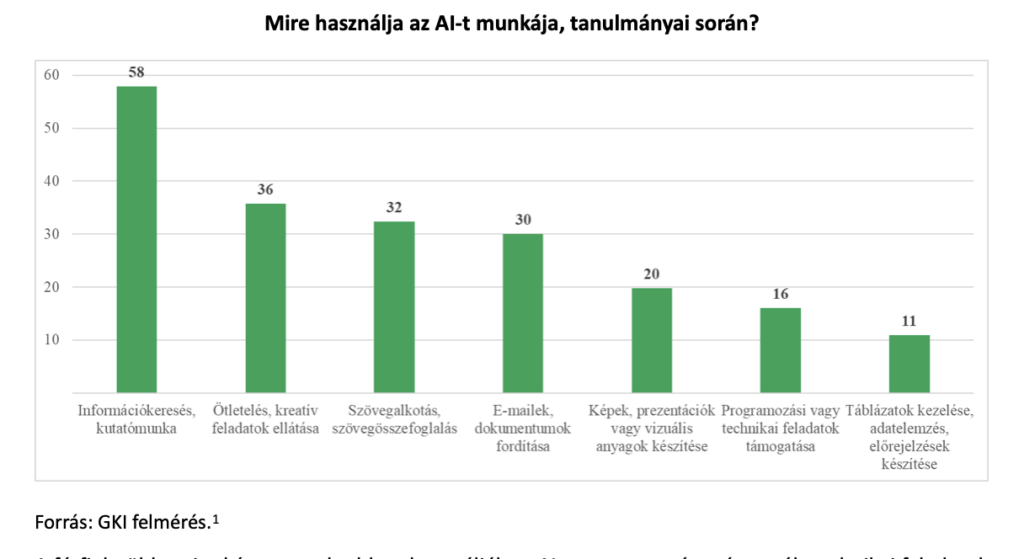We mostly use AI in the workplace for information retrieval
In July, GKI conducted a survey on the prevalence of artificial intelligence (AI) among the population on a representative sample of 1,000 people.
 As our previous analysis showed, 36% of the population uses AI at least moderately frequently during their work, while the proportion of private users is slightly higher (42%). Most people (58%) use AI tools for information search and research during their work. Many ask questions to artificial intelligence instead of traditional search engines (e.g. Google).
As our previous analysis showed, 36% of the population uses AI at least moderately frequently during their work, while the proportion of private users is slightly higher (42%). Most people (58%) use AI tools for information search and research during their work. Many ask questions to artificial intelligence instead of traditional search engines (e.g. Google).
The second most common purpose of use is brainstorming and performing creative tasks (36%). Nearly a third of respondents use AI for text creation and text summarization, and nearly the same number for translation.
A fifth of those surveyed create visual materials (presentations, images, etc.) with the help of artificial intelligence, while 16% use it for some programming or technical task.

Despite the fact that spreadsheets are part of everyday use in most office jobs, only one in ten regular users uses AI to help them manage spreadsheets and analyze data. The spreadsheet capabilities of large language models like ChatGPT are still far from ideal, but they are becoming increasingly powerful in data analysis.
Men are more than twice as likely to use AI for programming and other technical tasks as women. This is partly due to the underrepresentation of women in the STEM sector. However, women are more likely to use AI for almost all other purposes.
Students’ AI usage patterns differ significantly from the rest of society: 61% use it at least moderately, compared to just 39% of active workers. The average student using AI uses the tool for more things than the average worker.
The usage rate of students is higher in almost all areas of use, but the biggest difference is in text creation: 29% of employees use artificial intelligence for this, while this number is 65% for students. All this also indicates that the preparation of assignments and theses with AI assistance represents a huge challenge for teachers in higher education. It is interesting, however, that active employees translate texts at a higher rate (35%) than students (29%).
Independent intellectuals use AI less (11%), while entrepreneurs use it more often (63%) for idea generation than the average (36%). It is used mostly by employees in the public sector for information search (80%), by entrepreneurs for image creation (33%), while independent intellectuals are at the forefront when it comes to programming (34%).
Related news
Bagels, stuffed cabbage and online scams – this could be the Christmas menu for many due to the rise in cybercrime
🎧 Hallgasd a cikket: Lejátszás Szünet Folytatás Leállítás Nyelv: Auto…
Read more >How will AI continue to shape our lives? Seven areas to watch in 2026
🎧 Hallgasd a cikket: Lejátszás Szünet Folytatás Leállítás Nyelv: Auto…
Read more >Perceived price increase index remains high
🎧 Hallgasd a cikket: Lejátszás Szünet Folytatás Leállítás Nyelv: Auto…
Read more >Related news
How do young adults celebrate?
🎧 Hallgasd a cikket: Lejátszás Szünet Folytatás Leállítás Nyelv: Auto…
Read more >Vajda-Papír celebrates Ooops!’s 15th anniversary with a hybrid AI campaign
🎧 Hallgasd a cikket: Lejátszás Szünet Folytatás Leállítás Nyelv: Auto…
Read more >Pre-holiday shopping at up to half price
🎧 Hallgasd a cikket: Lejátszás Szünet Folytatás Leállítás Nyelv: Auto…
Read more >






